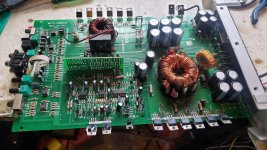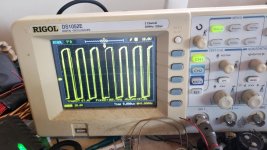It appears that your probe may need to be calibrated to the scope.
The scope trigger level may need to be adjusted.
The scope trigger level may need to be adjusted.
For the optocoupler near the driver board, solder a bridge between terminals 1 and 2. Does that stop it from going into protection?
If not, remove that bridge and solder between 3 and 4 to see if that stops it from going into protection.
If not, remove that bridge and solder between 3 and 4 to see if that stops it from going into protection.
I want to tell you something before I am trying those with ootocoupler.
The inductor was bad looking powdery inside I removed and used heat sink sleeve and wind back two turns.. Inductor still looks dirty so can't see proper. While it going into protect I am hearing a click noise near inductor.
The inductor was bad looking powdery inside I removed and used heat sink sleeve and wind back two turns.. Inductor still looks dirty so can't see proper. While it going into protect I am hearing a click noise near inductor.
For the optocoupler near the driver board, solder a bridge between terminals 1 and 2. Does that stop it from going into protection?
If not, remove that bridge and solder between 3 and 4 to see if that stops it from going into protection.
I bridge pin1 and pin2 now it is not going into protect.
That should be the DC offset circuit. There is a transistor near the output filter caps. It should have 3 diodes with it. If so, remove the bridge on the opto and remove that transistor to see if the amp goes into protect mode.
There was big dry black glue on the 3 diodes and resistors in that place. I cleaned it thinking if that black substance is conducting pins. When I tried amp now it is not going into protect. But current pull is going up and down as the signal strength is increased or lowered. And mosfets getting hot. Gate drive is 100khz. Is all these sounding normal?
In similar amps, the inductors often shorted but it appears that the one in this amp is fixed solidly to the board. If the fixative appears to have been applied by someone other than the manufacturer, they may have done it to prevent the windings from wearing through.
As a side note, I've never seen the black fixative to be conductive. The beige fixative that turns black is the stuff that becomes conductive. Something in that area may have been damaged.
As a side note, I've never seen the black fixative to be conductive. The beige fixative that turns black is the stuff that becomes conductive. Something in that area may have been damaged.
- Home
- General Interest
- Car Audio
- Boss CX3500D

